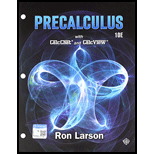
Angle of Rotation The restaurant at the top of the Space Needle in Seattle, Washington, is circular and has a radius of 47.25 feet. The dining part of the restaurant revolves, making about one complete revolution every 48 minutes. A dinner party, seated at the edge of the revolving restaurant at 6:45 P.M., finishes at 8:57 P.M.
(a) Find the angle through which the dinner party rotated.
(b) Find the distance the party traveled during dinner.
a)
To find:
The angle by which the dinner party is rotated from 6-45 P.M to 8-57 P.M.
Answer to Problem 1PS
Solution:
Explanation of Solution
Given,
The radius of the circular restaurant
Time of one complete revolution of the dining part
Duration of the dinner party is from 6-45 P.M to 8-57 P.M.
The party between 6-45 P.M to 8-57 P.M corresponds to the duration of 2 hours and 12 minutes or 132 minutes.
First let us calculate the angle by which the dinner party is rotated in a minute.
Angle by which the dinner party rotated in
Thus, the angle by which the dinner party rotated in.
Now, the angle by which the dinner party rotated in 132 minutes is,
Therefore, the dinner party was rotated through the angle of
b)
To find:
The distance by which the party travelled during dinner.
Answer to Problem 1PS
Solution:
816.01feet
Explanation of Solution
Given,
The radius of the circular restaurant
Time of one complete revolution of the dining part
Duration of the dinner party from 6-45 P.M to 8-57 P.M.
The dinner party was rotated by the angle of
Thus, the dinner party completes two full rotations
Thus, two full rotation corresponds to twice the circumference of the circular dinner party and a
Thus, total distance is given by,
Therefore, the dinner party was rotated by the distance of 816.01feet.
Want to see more full solutions like this?
Chapter 4 Solutions
Bundle: Precalculus, Loose-leaf Version, 10th + WebAssign Printed Access Card for Larson's Precalculus, 10th Edition, Single-Term
- Decide whether each limit exists. If a limit exists, estimate its value. 11. (a) lim f(x) x-3 f(x) ↑ 4 3- 2+ (b) lim f(x) x―0 -2 0 X 1234arrow_forwardDetermine whether the lines L₁ (t) = (-2,3, −1)t + (0,2,-3) and L2 p(s) = (2, −3, 1)s + (-10, 17, -8) intersect. If they do, find the point of intersection.arrow_forwardConvert the line given by the parametric equations y(t) Enter the symmetric equations in alphabetic order. (x(t) = -4+6t = 3-t (z(t) = 5-7t to symmetric equations.arrow_forward
- Find the point at which the line (t) = (4, -5,-4)+t(-2, -1,5) intersects the xy plane.arrow_forwardFind the distance from the point (-9, -3, 0) to the line ä(t) = (−4, 1, −1)t + (0, 1, −3) .arrow_forward1 Find a vector parallel to the line defined by the parametric equations (x(t) = -2t y(t) == 1- 9t z(t) = -1-t Additionally, find a point on the line.arrow_forward
- Find the (perpendicular) distance from the line given by the parametric equations (x(t) = 5+9t y(t) = 7t = 2-9t z(t) to the point (-1, 1, −3).arrow_forwardLet ä(t) = (3,-2,-5)t + (7,−1, 2) and (u) = (5,0, 3)u + (−3,−9,3). Find the acute angle (in degrees) between the lines:arrow_forwardA tank initially contains 50 gal of pure water. Brine containing 3 lb of salt per gallon enters the tank at 2 gal/min, and the (perfectly mixed) solution leaves the tank at 3 gal/min. Thus, the tank is empty after exactly 50 min. (a) Find the amount of salt in the tank after t minutes. (b) What is the maximum amount of salt ever in the tank?arrow_forward
 Glencoe Algebra 1, Student Edition, 9780079039897...AlgebraISBN:9780079039897Author:CarterPublisher:McGraw Hill
Glencoe Algebra 1, Student Edition, 9780079039897...AlgebraISBN:9780079039897Author:CarterPublisher:McGraw Hill Trigonometry (MindTap Course List)TrigonometryISBN:9781337278461Author:Ron LarsonPublisher:Cengage LearningAlgebra & Trigonometry with Analytic GeometryAlgebraISBN:9781133382119Author:SwokowskiPublisher:Cengage
Trigonometry (MindTap Course List)TrigonometryISBN:9781337278461Author:Ron LarsonPublisher:Cengage LearningAlgebra & Trigonometry with Analytic GeometryAlgebraISBN:9781133382119Author:SwokowskiPublisher:Cengage College Algebra (MindTap Course List)AlgebraISBN:9781305652231Author:R. David Gustafson, Jeff HughesPublisher:Cengage Learning
College Algebra (MindTap Course List)AlgebraISBN:9781305652231Author:R. David Gustafson, Jeff HughesPublisher:Cengage Learning Algebra and Trigonometry (MindTap Course List)AlgebraISBN:9781305071742Author:James Stewart, Lothar Redlin, Saleem WatsonPublisher:Cengage Learning
Algebra and Trigonometry (MindTap Course List)AlgebraISBN:9781305071742Author:James Stewart, Lothar Redlin, Saleem WatsonPublisher:Cengage Learning Trigonometry (MindTap Course List)TrigonometryISBN:9781305652224Author:Charles P. McKeague, Mark D. TurnerPublisher:Cengage Learning
Trigonometry (MindTap Course List)TrigonometryISBN:9781305652224Author:Charles P. McKeague, Mark D. TurnerPublisher:Cengage Learning





